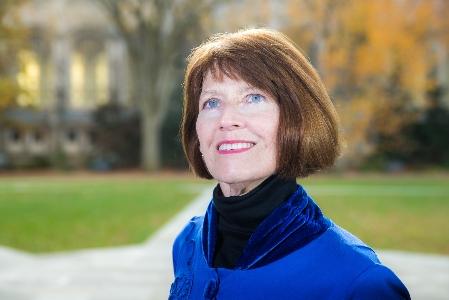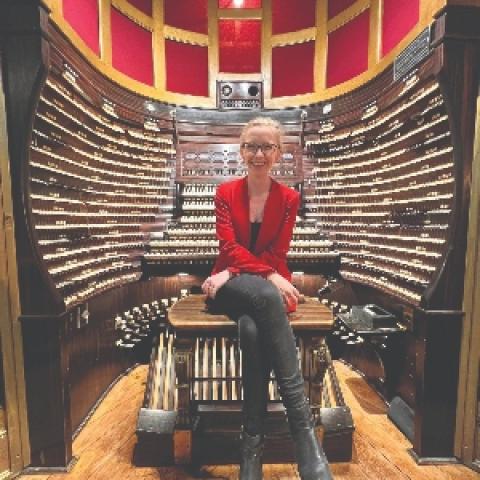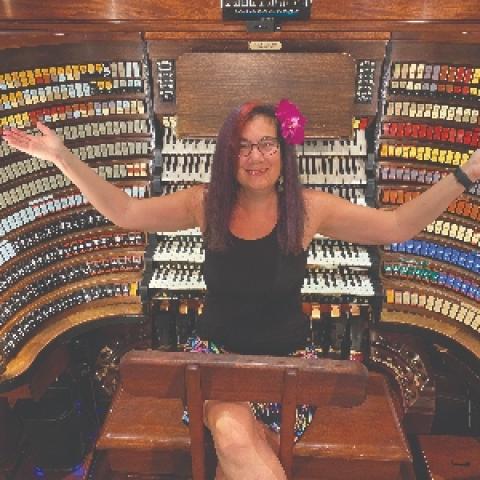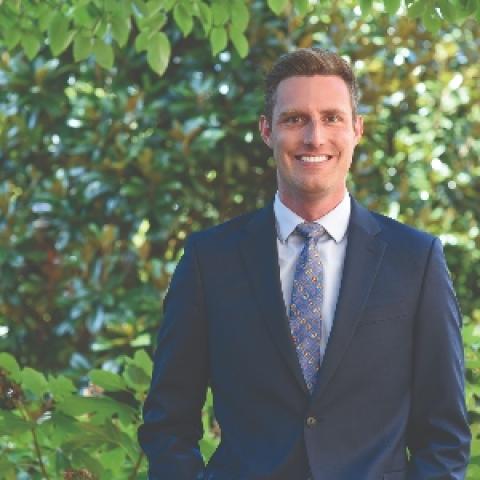Samuel Russell is the library and archival collections manager at Bok Tower Gardens in Lake Wales, Florida. He oversees the Anton Brees Carillon Library and the Chao Research Center, which houses the archives of the Bok Tower Gardens Foundation and its predecessor, The American Foundation. The Chao Research Center is also home to many artifacts related to the founder: Edward W. Bok.

This interview took place February 19, 2022, at the Blue Palmetto Café on the campus of Bok Tower Gardens, Lake Wales, Florida. Pamela Ruiter-Feenstra was studying with Geert D’hollander and playing four concerts at Bok Tower during the week of February 14–19, 2022. I conducted this interview before Pamela had a meeting with Geert. The conversation ended a little early as we heard the bells chiming in the background, which reminded us that it was time for her meeting.
I have Pamela Ruiter-Feenstra with me today. She is a carillonist in Ann Arbor, Michigan.
I play mid-day recitals at the University of Michigan.
And you are also on faculty there?
Not right now. I was the visiting carillonist at the University of Michigan during the 2019–2020 academic year, when Tiffany Ng was on a fellowship leave.
How long have you been playing the carillon?
Eight years. I first started playing the piano when I was a child. Then I added the organ when I was about twelve. As an undergraduate, I majored first in piano and then organ and choral music education, and then went on to pursue a Master of Fine Arts and doctoral degrees in organ with secondary music theory, conducting, and sacred music fields.
Were you aware of the carillon during your childhood?
No, I didn’t live near a carillon in my childhood. It was only when we moved to Ann Arbor and I took the organ professor position at Eastern Michigan University that I started hearing the bells. I was so enchanted by their time keeping capabilities, but also by their role as messengers—that they could speak to the moment of any given day.
The history of letting people know if there was a special event going on, or pirates were coming, or whatever the news was.
Exactly. I had a sabbatical in Ostfriesland, Germany, to study and play historic instruments there. The oldest organ in that area was from 1457 in Rysum, and the church had a bell that was tuned to a low E, the same low E as the pitch on the organ. In his Fundamentum Organisandi (1452), Conrad Paumann composed E drones with figuration above the repeated Es. The pastor of the Rysum church at that time loved the bell. Every time I’d go to practice, she’d say to me, “Shall we play? Can we do the bell and organ piece?” For that E drone in the Paumann piece, she would keep pulling the bell to ring repeatedly in rhythm, and I’d play the Paumann figuration above it. We had so much fun playing that fifteenth-century “duet.” She called it the “Echt Rysumer Hit,” or the true hit from Rysum. A fifteenth-century piece was their town hit!
But then we had to stop because Rysum is in a rural area and the farmers were plowing their fields. They could hear the bells miles away, kilometers away, and for centuries they used the bells to signal when someone died. They would ring the bell the number of times that corresponded with the age of the newly deceased person. The farmers would stop their tractors and start counting: eighty-two, eighty-three . . ., “Oh, it must not be Berta.” Eighty-four, eighty-five . . ., “I wonder if it’s Henk.” Eighty-six . . . . While the pastor and I were playing, they’d hear the bell over and over, and they got stirred up wondering, “Who in our community died?” So that is why we had to stop.
That is fascinating. It definitely means something to that culture and how the bells were translating a message, or sharing the message of something. Did you find it an easy transition from the piano and organ to picking up playing the carillon?
Well, knowing the keyboard layout and playing with my feet translated from the organ, but as for the dimensions, it was a whole new haptic awareness, because it’s like playing on a keyboard built for a giant instead of using a five-finger technique.
I also play the harpsichord and clavichord. The clavichord taught me a lot about arm weight and getting the most beautiful tone. And even though the clavichord is the quietest keyboard instrument, I found the technique of playing it the most helpful in teaching myself how to play the carillon. When I first learned to play the clavichord, I would just sit at the keyboard for hours and think, how do I get the best sound?
Okay, that note bloomed a little, but could it bloom more? And that note sounded choked. Why?
It’s important to ask these questions. I’m an improviser, which helps to let my ears guide first. I find that I can bring out the soul of the instrument better if I initially improvise on it rather than reading music because then my eyes can take over.
That is a very interesting word choice: can you go more into it? Finding the soul of the instrument.
I discovered this when playing historic organs and then harpsichords and clavichords. Each instrument is different, just as each carillon is different. There are some schools of thought where people impose a technique, usually the same technique, on every instrument they play. Even if they’re Steinway artists, Steinways differ from one piano to the next. I find that the finest, the most sensitive and expressive musicians seek to pull out the sound that the instrument most wants to make. So you pay attention to where the most resonance can be found. Is it in the bass or tenor? Is it in the treble? And what does that tell me about what repertoire I choose? Or about what kind of weight I’m distributing here or there? And what parts must be softer so that the melody comes out? What effects communicate well?
When you’re playing and listening to the instrument in real time, how do you become one with the instrument as you’re playing it so that there is that intimate connection?
It is again improvisation. If I am struggling with a passage or hearing something that doesn’t sound optimal to me, then I’ll take that passage and I’ll create an improvisation that is similar to it to figure out. When I take my eyes out of the equation, it opens up the ears. The instrument will speak. It will, it will . . .
Tell you what it wants to play?
It really does, by the quality of the sound. How much color comes, how much bloom? Does it sound forced? Does it sound weak?
What are your favorite types of things to play on the carillon?
I love Geert D’hollander’s music and how he plays the carillon so sensitively. I’m also strongly committed to presenting works from underrepresented composers and cultures and to broaden our repertoire and audience to be diverse and inclusive.
Let’s talk about both of those aspects. First, are you referring to Geert’s original compositions?
His original compositions. He is such a fabulous composer, and each piece is different. His works never sound like cookie-cutter replicas of each other. There is always something fresh in them and yet something historically grounded where you can tell how much music he’s listened to and how much he has studied. Every time I see he has published something else I want to get it and play it because it is just magnificent. And having the opportunity to coach with him here at Bok Tower is just such a dream. It is thanks to the Emerging Artists grant I received from the Guild of Carillonneurs in North America (GCNA) to come here.
The Emerging Artists grant is new and for people who have passed the carillonneur exam in the past three years. It is a wonderful opportunity. It is not like you’re done studying when you pass the GCNA certification exam. I consider that a new beginning, and I think it is really brilliant of the GCNA to offer the award to encourage people to go deeper and to get to the next level of expressive playing or understanding repertoire.
And because I am a composer and Geert is a composer we are talking about compositional techniques, too. I’m sharing my compositions with him, and he is giving me some great feedback on it, saying, “This is lovely, but this—maybe it’s in G minor too long,” or that kind of thing. And then I’ll say to him, “That is exactly what I was thinking. Let’s talk about that.” Then he shows me some of his new compositions that haven’t been published yet, and we talk about them.
I wrote two books on Bach and the Art of Improvisation. Geert improvises, too. So today we are going to have a session about carillon improvisation in the style of Bach, because he recently was commissioned to take some of Bach’s cello or gamba suites, unaccompanied, and arrange them for carillon, but with a twist. He is giving a kind of modern commentary on them, but you can still hear Bach in them. I create improvisation blueprints from Bach preludes and use the same unaccompanied gamba suites for the organ and the harpsichord, and I have written about this in my books. So today we are going to take my books and then the music of Matthias Vanden Gheyn, the well-known Baroque carillon composer whose three-hundredth anniversary we celebrated last year, and we are going to talk about how this might come full circle so that we can develop an improvisational method for the carillon. A carillon student, Carson Landry, will join us.
This opportunity is hugely stimulating. What a beautiful setting to be here in the Bok Tower Gardens and have access to the carillon all day long—into the evening. That is very rare. Most towers have very limited playing time, but here, the playing time is not restricted, and Geert is accessible, kind, and generous with his time, and we are having a blast.
I’d like to delve into your history as a composer and learn more about your style.
Because I’ve studied and performed a lot of early music, I’ve composed in a Baroque or even earlier Renaissance style as well for some of my organ works. But then I started getting commissions for organ. One of the commissions was from a brilliant young organist, Wyatt Smith, who wanted six pieces for a liturgical cycle entitled Liturgy LIVE! He wanted each piece to have a world influence. I started digging into ethnomusicology and finding music from all over the world and figuring out what aspects I could combine. Wyatt also wanted German chorales from the seasons to be featured with that world music. It was an interesting pairing.
Can you tell me more about what that means?
My daughter is from Ethiopia, so I took some Ethiopian rhythms and combined them with a chorale, for instance. I paired a Yoruban lament from Nigeria with the Advent chorale Nun komm, der heiden Heiland. I featured a French Romantic toccata with the Pentecost chorale Komm, heiliger Geist. Each piece had a different character and musical features from around the globe.
What else inspires you in your writing?
When I came to the carillon, I became acutely aware that this is a public instrument. In Ann Arbor we have students from around the world. So, I’d come out of the tower and hear all sorts of world languages and see people from around the world and then I would think, I’ve just played all this music by dead European men. Right? That is not the demographic here. Even though there are some people from European descent, that doesn’t represent everyone—it excludes a lot of people.
How does this public instrument connect with people from around the world? And imagine how much wonderful music the carillon has been missing when so many cultures haven’t been represented! Then I started thinking that my compositional direction must be to lift up the voices that have been missing from classical keyboard music. I interviewed people from the African American, Muslim, and Arab communities, a Jewish Holocaust survivor, and then several people from the Latin community. I asked them about their experience with prejudice. They were incredibly generous in telling their stories. They said they were really glad that somebody finally asked. They wanted to talk and then they gave me permission to write pieces about their stories. It was cathartic for them in that they felt silenced when they were experiencing discrimination, but through this music, they had a voice. And now there was a way to claim agency in a situation where they’d had no agency.
You’re taking feelings from what people tell you and then putting that into the feeling of the music.
The feelings are there definitely, and that’s extremely important to me to get into the right affect for the piece, and the character and style of music. But I’m actually telling a story as well. So the piece I’ll play at Bok Tower today, Earth Blood Reprise, is about a woman, Jackie Doneghy, who grew up in Oberlin, Ohio, and studied with top piano professors when she was in middle school and high school. When she auditioned for a conservatory (not Oberlin), she was heckled because the head of the department didn’t want to allow an African American person into the conservatory. As a result, she dropped the piano and never came back. Her story is implanted into Earth Blood Reprise. I include quotes from Lift Every Voice and Sing, Beethoven’s Moonlight Sonata, and spirituals.
How do you take the story and then put it into music notation?
I’ve also been getting into storytelling with journalists. I collaborate with international journalists from the Knight-Wallace fellowship program at the University of Michigan. I compose music on stories that they have not been able to report on. The stories are under-reported and some of the journalists have been censored. These journalists and filmmakers and I founded Collaborative Investigative Composing (CIC) to tell these stories via music and document them in music scores and film.
The process is a little different for each CIC, depending on how much the storyteller wants to get involved in the music notation. I’ve worked with Jet Schouten, a Dutch journalist who took twenty years of piano lessons. Jet wanted to play the notes on the carillon that she wanted in a CIC composition, while I notated the music. Venezuelan journalist Marielba Núñez played themes and effects on the carillon while she verbally told me the stories of Venezuelans who are fleeing the authoritarian government and humanitarian crisis. I took Marielba’s themes and developed them more to fit with her stories. At that point, I play what I notated and ask the storytellers whether the music tells their story effectively or whether something is missing.
Marielba is also a poet, and she has a keen ear for form, structure, and balance. She’s not a musician, but she could describe in literary terms the changes she suggested.
When Jackie gave up the piano due to the audition trauma she endured, she became a singer instead. She asked for some spirituals to be included along with Lift Every Voice and Sing, and then I added the Moonlight Sonata, because that is one of the pieces she played on the piano. Including the Beethoven was a way for Jackie to reclaim it in her own voice, not in the disparaging voice. So there are layers there. A general audience may not know the story there unless there are program notes or if a performer has a chance to talk with them. This means, of course, it is also really important that the music can stand alone, which it absolutely does.
People will ask me questions about it afterwards, and they’ll say, “That is such an intriguing piece. Tell me about it.” And then we have a chance to talk about it after the concert.
As an example, on Saturday (February 19, 2022) at Bok Tower, I performed Earth Blood Reprise along with some pieces from The Music of March: A Civil Rights Carillon Collection edited by Tiffany Ng, some spirituals, including Go Down, Moses and Sometimes I Feel Like A Motherless Child, which I arranged in Global Rings, and Joey Brink’s arrangement of Lift Every Voice and Sing. After the concert, an African American man approached me and he said, “Thank you for including music for us. I like the sound of the bells, but I never thought I’d hear something that directly speaks to our experience. It makes such a difference.” He then told me that as he walked around the gardens listening, he met several other African Americans, and each one of them would smile and nod, or wink, or show a thumbs up that indicated that they, too, felt included by the carillon that day. He asked about Earth Blood Reprise and wanted to hear more of the story. At the same time, he said that the piece spoke to him before knowing the story. Hearing the story served to deepen his experience.
How it is different composing for the carillon in comparison to the piano, the organ, or even the harpsichord. What is unique about the carillon specifically?
Fewer notes can be played at once on the carillon compared to other keyboard instruments. I think of composing for the carillon often as a Schenkerian reduction that happens before the bigger or more expanded piece is actually written. Writing for the carillon must be sparse. I think about the strong minor third partials and not having dense chords especially in the tenor-bass range because then the resonances cancel each other out as they vibrate for so long. If there are two voices close together in thirds, for instance, they really need to be in the treble. But those are technical details.
I mentioned my work with journalist Marielba Núñez to tell stories via music about the humanitarian crisis due to an authoritarian government in Venezuela. Journalist Eileen Truax and filmmaker Diego Sedano reported on the untenable conditions people fled from in Mexico and the issues they face due to unjust U.S. immigration policies. I’m starting to write an oratorio based on those stories. A former TV news anchor and filmmaker from Belarus joined in a CIC piece that demonstrates how an authoritarian head of state forces the media to tell lies to the people. One journalist, Tracie Mauriello, reported on school shootings in the U.S.: gun violence. Another journalist, Ana Avila, reports on misogyny and gender violence in Mexico. Dutch journalist Jet Schouten and I collaborated in a pandemic response, Healing Bells, which was premiered simultaneously by carillonists in fourteen countries. Healing Bells contains an arrangement of Plyve Kacha, a Ukrainian lament.
I return to your question about how we collaborate. When I meet with a journalist in person, I can take them to a carillon, just as happened with Marielba and Jet Schouten. Then I actually ask them to play the feeling of their story on the carillon while they’re telling the story to me a second time around. First, we just sit like this across a table and talk. And then, the second time, even if they haven’t had music lessons before and I might say, play just the black keys and then everything you play will sound good. I get them started with pentatonic modes, so that they can stay focused on the affect of the story. Inevitably they come up with a really interesting theme. And then I build on their theme and use that as a unifying theme throughout their piece.
You say it is people who don’t know music. But everyone kind of intuits that these are the low keys and these are the high keys. For the carillon it’s playing with your fists. You strike the keys, and you might depict your frustration by playing on low keys or reflect your high points on the high keys, and then you might play in the middle of the keyboard. It is an interesting way to get them to express their internal story in an alternative way.
It is so important to the journalists to be able to tell these stories first of all, and with censorship for some of them, these are stories they haven’t been able to tell. And secondly, they feel really strongly that it is important—as an archivist, you’ll appreciate this—to preserve these stories. Otherwise, those stories are erased. They have been erased now in the present, but if they’re also erased in the future then these atrocities from authoritarian governments resulting in humanitarian crises will never come to light.
You said you work with the Knight-Wallace Fellows, and they’re at the University of Michigan?
Yes.
Is that relationship between the two entities—the carillon and the Knight-Wallace Fellows—something formally recognized by the university?
Lynette Clemetson, the director of the Wallace House, approaches me from year to year to ask whether I would present for the fellows. University of Michigan Carillon Professor Tiffany Ng has fully supported this, which has greatly helped to facilitate our CIC initiatives. From carillon presentations, the fellows themselves find out about our CIC way of telling stories. Then they are free to just approach me and say, “I’d love to do something. Can you collaborate?” It starts out rather informally and grows from there.
We at CIC are applying for grants. We really need some funding to create some short and full-length documentaries about our work so that these stories get preserved in music scores and film to reach wider audiences. We’d like to tour to a number of sites to integrate with communities who connect personally with the stories and places where no one knows about these stories and then to culminate with CIC performances. I usually compose a CIC first for carillon. Now, I’m developing CIC works for organ, chamber ensembles, orchestra, choir, soloists, etc. Our CIC team feels passionate about what we’re doing because it meets a need. It is cross-disciplinary, collaborative, and is dealing with a lot of social-justice issues. We’re going to find a way to continue.
To continue telling the stories that people need to share.
Yes, exactly.
Thank you for your time and for sharing what you’ve learned and your methodologies with me. I appreciate it.
Thanks so much for your invitation, Sam, it is really kind.
Bok Tower Gardens library website: boktowergardens.org/library/
Pamela Ruiter-Feenstra’s website: pamelaruiterfeenstra.com





